USING THE GREEN – RVACHEV’S QUASIFUNCTIONS METHOD IN THE NUMERICAL ANALYSIS OF ONE ELECTROSTATIC NANOELECTROMECHANICAL SYSTEM
DOI:
https://doi.org/10.20998/2079-0023.2022.02.02Keywords:
method of two-sided approximations, Green – Rvachev's quasi-function method, positive solution, theory of nonlinear operators, Urysohn’s equation, semi-ordered space, strongly invariant cone segment, heterotone operator, nanoelectromechanical systemAbstract
The problem of numerical analysis of one electrostatic nanoelectromechanical system is considered in the article. Nanoelectromechanical systems are miniature devices that combine electronic and mechanical components of micro and nano sizes. Electrostatic actuation of the mechanical components of such systems is one of the most common types of actuation and that used in accelerometers, switches, micro-mirrors, micro-resonators, etc. The disadvantages of such devices are related to the pull-in instability. This effect occurs when the voltage applied to the moving electrode exceeds a critical value, causing the system to lose its stationary configuration. A semi-linear elliptic equation with the Laplace operator and the first boundary condition was used for mathematical modeling of the process. To construct an approximate solution of the problem, it is suggested to use the methods of nonlinear analysis in semi-ordered spaces, in particular, the results of V. I. Opoitsev on the solvability of nonlinear operator equations with a heterotone operator. The boundary value problem modeling the nanoelectromechanical system is reduced to the integral Urysohn’s equation using the Green – Rvachev’s quasi-function method, which allows us to expand the application of the two-sided approximation method for domains of fairly arbitrary geometry. The article substantiates the possibility of constructing two-sided approximations to a positive solution of the problem, namely: a computational scheme is given, conditions for its convergence to a single positive solution of the problem under consideration are obtained, and an error estimate is obtained. The method is illustrated by computational experiments for a problem considered in a rectangular domain. The results of computational experiments are presented in the form of numerical and graphical information.
References
Pelesko J. A., Bernstein D. H. Modeling MEMS and NEMS. CRC Press, 2002. 351 p.
Sidorov M. V. Green-Rvachev’s quasi-function method for constructing two-sided approximations to positive solution of nonlinear boundary value problems. Carpathian Mathematical Publications. 2018, vol. 10, no. 2, pp. 360–375.
Konchakovskaya O. S., Sidorov M. V. Chislennyj analiz odnogo nelinejnogo ellipticheskogo uravneniya, voznikayushchego pri modelirovanii mikroelektromekhanicheskih sistem [Numerical analysis of one nonlinear elliptic equation that modelling microelectromechanical system]. Radioelektronika i informatika [Radioelectronics & Informatics]. 2016, vol. 73, no. 2, pp. 23–28.
Konchakovskaya O. S., Sidorov M. V. Primenenie metodov nelinejnogo analiza v matematicheskom modelirovanii mikroelektromekhanicheskih system [Mathematical modeling of microelectromechanical systems using methods of nonlinear analysis]. Bionika intellekta [Bionics of Intelligence]. 2017, vol. 88, no. 1, pp. 60–64.
Konchakovs'ka O. S., Sidorov M. V. Metod dvobіchnih nablizhen' u chisel'nomu analіzі odnієї mіkroelektromekhanіchnoї sistemi [The two-sided method in numerical analysis of one microelectromechanical system]. Vіsnik HNU іm. V.N. Karazіna. Ser. Matematichne modelyuvannya. Іnformacіjnі tekhnologії. Avtomatizovanі sistemi upravlіnnya [Bulletin of V. Karazin Kharkiv National University, Series «Mathematical Modelling. Information Technology. Automated Control Systems»]. 2018, vol. 39, pp. 33–41.
Konchakovska O., Sidorov M. Numerical Analysis of the OneDimensional Nonlinear Boundary Value Problem that Modeling an Electrostatic NEMS by Two-Sided Approximations Method. Journal of Numerical Analysis, Industrial and Applied Mathematics (JNAIAM). 2020, vol. 14, no. 3–4, pp. 17–26.
Lai B. On the partial differential equations of electrostatic MEMS devices with effects of Casimir force. InAnnales Henri Poincaré. 2015, vol. 16, no. 1, art. no. 239253.
Batra R. C., Porfiri M., Spinello D. Effects of Casimir force on pullin instability in micromembranes. EPL (Europhysics Letters). 2007, vol. 77, no. 2, art. no. 20010.
Rvachev V. L. Teoriya R-funkcij i nekotorye eyo prilozheniya [Theory of R-functions and its Some Applications]. Kiev, Naukova dumka Publ., 1982. 552 p.
Opojcev V. I., Hurodze T. A. Nelinejnye operatory v prostranstvah s konusom [Nonlinear Operators in Spaces with a Cone]. Tbilisi: Izdvo Tbilis. un-ta Publ., 1984. 246 p.
Krasnosel'skij M. A. Polozhitel'nye resheniya operatornyh uravnenij [Positive Solutions of Operator Equations]. Moscowб Fizmatgiz Publ., 1962. 394 p.
Guo D., Lakshmikantham V. Coupled fixed points of nonlinear operators with applications. Nonlinear Analysis: Theory, Methods & Applications. 1987, vol. 11, no. 5, pp. 623–632.
Esposito P., Ghoussoub N., Guo Y. Mathematical analysis of partial differential equations modeling electrostatic MEMS. Courant lecture notes in mathematics. Vol. 20. American Mathematical Soc. 2010. 318 p.
Downloads
Published
How to Cite
Issue
Section
License
LicenseAuthors who publish with this journal agree to the following terms:
- Authors retain copyright and grant the journal right of first publication with the work simultaneously licensed under a Creative Commons Attribution License that allows others to share the work with an acknowledgement of the work's authorship and initial publication in this journal.
- Authors are able to enter into separate, additional contractual arrangements for the non-exclusive distribution of the journal's published version of the work (e.g., post it to an institutional repository or publish it in a book), with an acknowledgement of its initial publication in this journal.
- Authors are permitted and encouraged to post their work online (e.g., in institutional repositories or on their website) prior to and during the submission process, as it can lead to productive exchanges, as well as earlier and greater citation of published work (See The Effect of Open Access).


